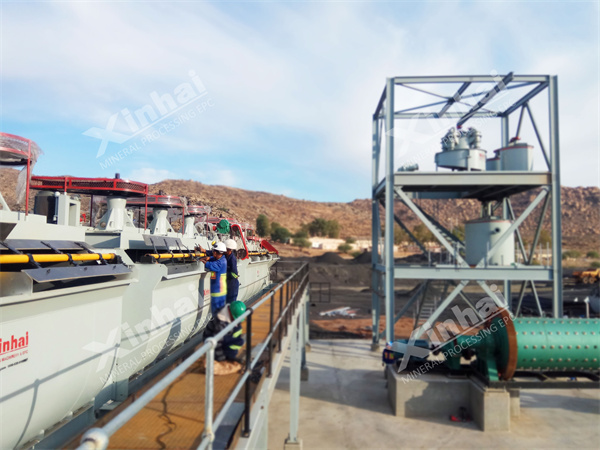The common forms of copper minerals are: copper sulfide, copper oxide and native copper. The purpose of copper ore dressing is to separate the unnecessary gangue minerals, leaving the valuable target minerals, and purify and concentrate them to obtain concentrate. Choosing the appropriate copper ore dressing process can obtain better concentrate grade and dressing recovery rate. The following introduces the steps of copper ore dressing process.
Before the copper ore enters the normal beneficiation process, it needs to be pretreated. The commonly used pretreatment processes are mainly:
(1) Crushing
The mined ore must first be crushed by a crusher to reduce the size of the ore. In the selection of crushing equipment, jaw crushers or cone crushers are usually used. The crushing process can adopt two-stage crushing or three-stage crushing to achieve the ideal crushing effect.
(2) Grinding
After the crushed ore is screened, the qualified material will enter the grinding stage (the unqualified material will be returned for further crushing). The commonly used equipment in this process is a ball mill, which can reduce the particle size to 0.15~0.2mm. The grinding process can adopt one-stage grinding or two-stage grinding.
(3) Classification
Classification equipment is mainly used to separate mineral particles according to their size, thereby improving processing efficiency. Commonly used classification equipment include spiral classifiers and hydrocyclones. Spiral classifiers are traditional classification equipment. In recent years, hydrocyclones have gradually replaced spiral classifiers. Its advantages are high classification efficiency, compact size, and large processing capacity.

The recovery of copper from copper sulfide minerals is mainly done by flotation. The working principle of flotation is to separate copper from gangue minerals by using the difference in surface properties, i.e., hydrophobicity and hydrophilicity. The steps of the flotation process are:
(1) Slurry preparation: The ground ore is mixed with water to form a slurry or pulp.
(2) Adjustment: Reagents are added to the pulp to selectively change the surface properties of the mineral. Collectors (such as xanthate) are used to make the copper sulfide mineral hydrophobic, while frothers stabilize the foam layer. Modifiers (including lime and cyanide) are used to control pH and suppress unwanted minerals such as pyrite.
(3) Flotation: Air is introduced into the pulp, and the resulting bubbles selectively attach to hydrophobic minerals, bringing them to the surface to form a foam layer. The foam rich in copper minerals is then collected. The hydrophilic particles remain in the pulp.
(4) Concentrate collection: The copper-rich foam is collected to obtain copper concentrate.
(1) Flotation:
Sulfidation flotation: This technique involves treating the oxidized ore with a sulfiding agent, such as sodium sulfide (Na2S), to form a surface coating of copper sulfide, which can then be floated using conventional sulfide collectors.
Direct flotation: This method utilizes specialized collectors such as fatty acids, soaps, amines, and chelating agents, which have an affinity for oxidized copper minerals.
Emulsion flotation: The oxidized copper mineral is first sulfided and then a copper auxiliary component is added to form a stable oil-wet surface
(2) Leaching (hydrometallurgy):
Heap leaching: The crushed ore is piled on an impermeable mat and irrigated with a leaching solution, usually dilute sulfuric acid. The copper-containing leachate is then collected and processed to recover the copper.
Barrel leaching (tank leaching): The copper-containing oxidized ore is leached using a concentrated sulfuric acid solution.
In situ leaching: This method involves injecting a leaching solution directly into the ore body through a borehole. The copper-containing solution is then extracted and processed.
Agitation leaching: fine ore particles are leached in an agitated tank with high concentration of sulfuric acid.
Copper recovery from leachate:
Solvent extraction (SX): selectively extract copper from the leachate into an organic solvent.
Electrowinning (EW): recover copper metal from the solvent extract by electrolysis.
Cementation: use scrap iron to precipitate copper from the leachate.
(3) Chemical beneficiation: used for some refractory oxides and mixed ores.
(4) Ammonia leaching: use ammonia and ammonium carbonate solution as solvents.
Mixed ores contain both sulfide and oxide minerals, so it is usually necessary to combine multiple beneficiation technologies. Methods include:
(1) Preferential flotation method
Preferential flotation method can preferentially float sulfides or oxides. For oxides, sulfidation treatment is required to form a floatable sulfide film on their surface.
(2) Mixed flotation method
Add mixed collectors (such as xanthate and amine collectors) and frothers, and float sulfide minerals and oxide minerals together through a flotation machine to obtain a mixed concentrate. After mixed flotation, mineral separation is performed.
Before determining the copper ore beneficiation process steps, you should first understand the mineral characteristics and composition. It is recommended to conduct a beneficiation test first, plan the beneficiation process methods and plans according to the properties of the ore, and select the type of beneficiation equipment, etc., in order to obtain better copper ore beneficiation results and obtain ideal economic benefits.